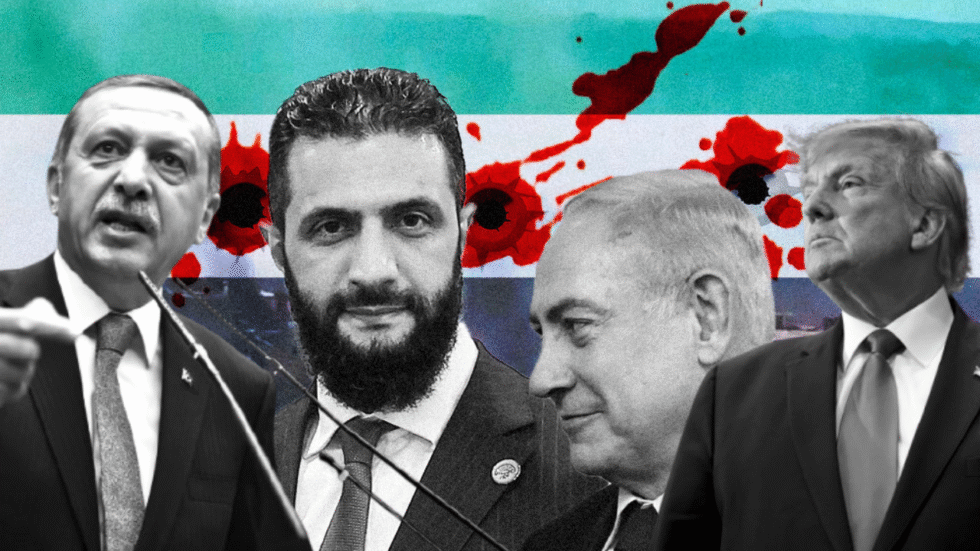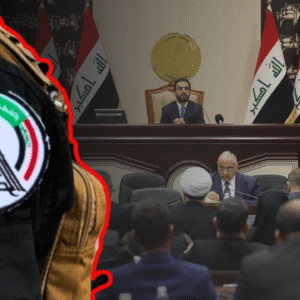Caught Between Agendas: How Foreign Powers Benefit from Syria’s Destabilization

Since the fall of Bashar al-Assad, Syria has become a chessboard for competing foreign agendas. From regional actors to global hegemons, each player appears committed to ensuring Damascus never reemerges as a unified, sovereign state.
Attempting to play all sides, de-facto president Mohammad Al-Julani has found himself stretched thin, struggling to reconcile external demands with deepening internal fractures.
The coastal massacres, the maneuvering over energy corridors, and the slow partitioning of influence across Syria are not unfortunate by-products of instability; they are the architecture of a deliberate strategy, in which perpetual fracture is the price of foreign control.
Israel’s Ideal Neighbor
Israel has never envisioned a strong Syria as a desirable neighbor. The occupation aimed to control southern territory from the Golan Heights through Daraa to Quneitra to expand its territorial reach, secure control of water sources, gain strategic leverage over Lebanon–and most important of all–contribute to the realization of the Greater Israel plan.
It developed a fragmentary security doctrine, as enshrined in the Yinon plan, which envisions internally fractured states carved along sectarian and ethnic lines.
Under Assad’s regime, that vision remained largely out of reach. Syria resisted Israel’s full occupation of the Golan and served as a supply line for the wider ‘axis of resistance.’ A telling example was Israel’s war on Gaza in 2008, which was supported by a Hamas base in Damascus with the help of late Iranian Quds Force leader, Qassem Soleimani.
Syria had thus become the connective thread synergizing the resistance axis’ efforts, cementing its status as a strategic threat in the eyes of Israeli policy makers, while fueling their fears of regional isolation.
What had long been a distant ambition became an achievable reality under Julani’s leadership, which opened the door to a familiar colonial playbook: pretexts, military strikes, and occupation.
Within hours of Assad’s fall, Israel moved to neutralize 80 percent of Syria’s defensive capacity, seize swathes of southern territory, and secure Mount Hermon—a strategic vantage point overlooking Lebanon.
More recently, it struck Damascus’s military HQ in a feigned response to the Suwayda massacres and in support of the Druze population — a well-worn pretext that has long provided cover for Israeli aggression without consequence.
This bombardment underscored that for Tel Aviv, the priority is not the survival of Julani’s already fragile leadership—despite his efforts to create direct lines of communication and insistence on ‘shared enemies’—but the exploitation of this period of uncertainty to etch its expansionist agenda into the fabric of Syria.
In this context, the ideal Syria is not a cohesive state, but a permanently fractured one; its sovereignty hollowed out, its regions divided among competing militias, and its governance too weak to mount any meaningful military or diplomatic challenge to Israeli interests.
David’s Corridor: Mapping Israel’s New Frontier
Beyond immediate security calculations, Syria sits at the heart of Israel’s wider regional ambitions.
Its geostrategic position makes it central to the realization of the David’s Corridor, an offshoot of the Greater Israel plan, which seeks to connect southeastern Syria to the Kurdish controlled northern territory, extending out towards the Iraqi border.
Such a measure would allow Israel to block Iran’s land bridge to Lebanon and create a buffer against Turkey, unlocking key oil and trade routes at once.
Viewed from a broader lens, the corridor would provide Israel with leverage over the tri-border between Jordan, Iraq, and Syria, giving it a channel to transport arms, gather intelligence, and access to confront adversaries on multiple fronts.
Israeli presence in Syria is therefore a calculated step toward redrawing the region’s map in its own image. By embedding itself permanently in Syrian territory, Tel Aviv gains access to areas which strengthen its standing against its foes.
This strategy has been dressed up by leveraging local actors like the Syrian Druze in the south and Kurdish separatists between the occupied Golan and Euphrates area as cover to advance its objectives. From the Golan Heights to the southern territories, Syria’s role in this map is indispensable.
Pipeline Diplomacy: Turkey’s Bid for Energy Dominance
In 2009, Qatar unveiled its plan to build a Turkey-Qatar gas pipeline via Syria, with the aim of reaching the European market. This dream was cut short by diplomatic friction between Ankara and Damascus as Assad’s regime preferred a rival route linking Iran to Syria via Iraq.
At the time, Iran was meeting an estimated 90 percent of Syria’s oil demands, receiving 60,000 to 70,000 barrels of crude oil per day, with the remaining 10 percent drawn from Syria’s own oil fields.
Assad’s fall dried up this well. For Turkey, however, it unlocked once distant economic opportunities to extend its regional influence. Beneath Ankara’s public pledges to revitalize Syria’s energy sector and play a vital role in Syria’s reconstruction lies a strategic objective: to secure key trade and energy corridors, and to weave Syria into new pipeline networks that create long-term economic dependency.
Ankara pledged to supply Syria with 2 billion cubic meters of natural gas annually, and signed a $7 billion dollar energy deal with a consortium of US and Qatari firms. On Aug. 2, Azerbaijan and Syria launched a new gas transmission pipeline linking Baku to Damascus via Turkey.
Turkey’s ambitions in Syria cannot be viewed in isolation from its deepening alliance with Azerbaijan—a partnership rooted in shared ethnic, linguistic, and strategic ties.
This trilateral infrastructure marks more than just an economic project; it represents a geopolitical corridor designed to reinforce Turkish influence deep into Syria while undercutting competing routes backed by Israel and other foreign actors.
These moves signal a concerted Turkish bid to rebrand itself as the region’s central energy hub, through constructing the infrastructure needed to anchor Ankara at the heart of regional power flows, while keeping under its grip key oil and gas arteries.
In the long term, this strategy is about both securing regional leverage, and positioning Turkey to assume its long desired ambition of becoming the primary regional supplier of non-Russian gas to Europe.
Pipeline Rivals: Competing Roads to Regional Power
Turkey’s approach to expanding influence differs from Israel. Ankara prefers to wield diplomacy, infrastructure, and proxy forces over direct military occupation. Yet the end goal of increasing regional dominance remains the same, which makes room for friction inevitable.
One of these points of friction is energy. Tel Aviv has long sought a stake in the European gas market, most prominently through the now-stalled EastMed pipeline.
The proposed route would carve a path to Europe via Cyprus, Greece, and Italy, but faced funding issues, competition from cheaper alternatives, and Turkish opposition over the use of Cyprus, where Ankara’s maritime claims directly challenge Israeli ambitions.
Now, the newly inaugurated Baku-to-Damascus route, facilitated by Ankara, threatens to sideline Israel from lucrative energy corridors and erode its leverage in Europe’s race to replace Russian gas.
Turkey’s growing upper hand in the pipeline game has pushed Israel back to familiar ground. On Aug.7, it announced a $35 billion deal to supply gas to Egypt via its Leviathan field—the largest export deal in Israel’s history. Since 2020, the Leviathan has been the cornerstone of Israel’s gas exports, providing both economic revenue and regional leverage.
But as Ankara consolidates its role as a regional energy hub with backing from Azerbaijan, Qatar, and even US firms, Israel faces the prospect of being edged out of a game it long sought to dominate.
This raises the stakes in southern Syria, where control over infrastructure and influence over local factions is increasingly tied to larger geopolitical and economic contests.
From Integration to Stalemate: The Race for Influence in the Northeast
After Assad’s fall, Turkey pounced on the opportunity to curb the Kurdish threat in northeastern Syria. Within months, Damascus struck an agreement with Kurdish-led, US-supported Syrian Democratic Forces (SDF), calling for the group’s integration into Syrian state institutions and the military, and the handover of oil fields under its control within a year.
Simultaneously, pressure mounted on the Kurdistan Workers Party (PKK), resulting in its leadership’s announcement that its war with Turkey had come to a dead end. Yet, continued attacks and massacres of minorities by Syrian government forces, have already begun to stall the SDF integration.
“The lack of a transparent military structure in Syria, especially following violence in Alawite regions on the coast and in the southern Druze-majority province of Suwayda, complicates the possibility of integrating the SDF into its military structure.” AANES Foreign Relations Co-Chair Elham Ahmad stated on July 25
Tensions deepened on Aug. 7, when efforts emerged to establish a link between Suwayda in southern Syria and SDF-held territory in the northeast; a move inching closer to realizing Israel’s David’s Corridor. For Ankara, this represented a direct national security threat, layered atop frustrations over the SDF’s refusal to fully integrate.
Accordingly, Turkey’s backing of former ISIS commander Julani has proved to be a double-edged sword. Though Assad’s fall was seen as the final piece in the puzzle to redraw the region, the reality has been far messier; new government forces assembled from an extremist support base have unleashed violence, aggravated minority tensions, and opened space for competing foreign agendas all seeking influence.
In the race to gain the upper hand, Turkey’s and Israel may find themselves repeatedly colliding over the spoils of Syria’s fractured future.
Washington’s Velvet Glove
While it may seem that the US has shifted its posture from overt dictator to passive observer, this transformation should not be mistaken for disengagement or disinterest in West Asia’s unfolding dynamics.
Rather than retreating, Washington has simply changed its tactics, exchanging the iron fist for a velvet glove. What emerges is not a withdrawal, but a recalibration; the US as shadow dictator, quietly repositioning the chess pieces for the next phase of the game.
Tom Barrack, US Emissary to Syria, is central to this transformation. Tasked with recalibrating US policy in West Asia, Barrack’s mission is to secure continued American dominance by indirect means. This strategy involves aligning Ankara to Washington and Tel Aviv’s aims for Syria and the wider region.
This is being pursued by drawing Turkey deeper into US-led energy initiatives, particularly through liquefied natural gas (LNG), as a counterweight to China’s Belt and Road Initiative (BRI) while simultaneously dangling infrastructure incentives to solidify the partnership.
These maneuvers are not confined to Syria. The recent US-led push for Hezbollah disarmament should be viewed as part of the broader attempt to weaken the resistance axis, where Syria was the first success story that provided momentum for the cause.
The objective is clear: dismantle the resistance by isolating it, turning the Lebanese struggle against Israeli occupation into an internal war against Israel’s enemies, reframed and repackaged through the prism of security.
Syria at the Mercy of its Mapmakers
Since Julani’s rise, the pieces have fallen neatly into place for deeper Israeli occupation, expanded Turkish control, and entrenchment of sectarian rivalries. For each player, a fractured Syria has become an asset.
Now severed from the wider resistance, Syria’s once formidable strategic potential has been reduced to spoils parceled out as foreign states compete for dominance over energy routes and infrastructure.
Syria’s survival depends on a leader that puts national unity above regional bargaining — a figure committed to sovereignty and security, not a broker for Western agendas and foreign capital. Until then, the country will remain a board on which others play their game.
If you value our journalism…
TMJ News is committed to remaining an independent, reader-funded news platform. A small donation from our valuable readers like you keeps us running so that we can keep our reporting open to all! We’ve launched a fundraising campaign to raise the $10,000 we need to meet our publishing costs this year, and it’d mean the world to us if you’d make a monthly or one-time donation to help. If you value what we publish and agree that our world needs alternative voices like ours in the media, please give what you can today.





















